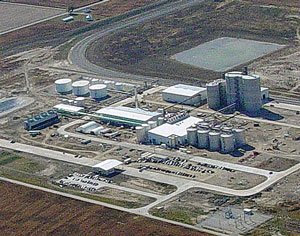 The Specialty Equipment Market Association (SEMA) is holding their annual show in Las Vegas and Jay Leno’s Ecojet is on display. Besides the team from Jay Leno’s Garage, Joe Jobe, NBB CEO is also there to speak with the media and attendees. This is not a consumer show btw.
The Specialty Equipment Market Association (SEMA) is holding their annual show in Las Vegas and Jay Leno’s Ecojet is on display. Besides the team from Jay Leno’s Garage, Joe Jobe, NBB CEO is also there to speak with the media and attendees. This is not a consumer show btw.
I just spoke with Joe via Skype from my computer to his mobile phone on the show floor. He says it’s a big show and the “sassy” Ecojet is a big attraction for a lot of reasons, not the least of which is the fact that it runs on B100 and is totally environmentally friendly. I think the fact that it’s a Corvette with a jet engine also has something to do with it too.
You can listen to my interview with Joe here: [audio:http://www.zimmcomm.biz/biodiesel/nbb-sema-jobe.mp3]
Or you can download the interview with this link (12 min. mp3 file).
Joe and the NBB have continued a working relationship with Jay Leno that started with New Holland’s involvement about a year and a half ago out in Jay Leno’s Garage. Since then Jay’s car has toured the country touting the benefits of biodiesel and raising awareness for the renewable fuel.
Besides working with Jay Leno I know that NBB and New Holland have also begun a relationship with Rolling Stones keyboardist, Chuck Leavell, whom I’ve met and interviewed several times. Joe also speaks to the importance of having a music celebrity like him involved in spreading the word about biodiesel.


 The
The  “The focus of the site is to allow producers and stakeholders to openly share ideas and experiences gleaned from raising and marketing switchgrass and other biomass energy crops,” says site host and switchgrass farmer Andy Bater.
“The focus of the site is to allow producers and stakeholders to openly share ideas and experiences gleaned from raising and marketing switchgrass and other biomass energy crops,” says site host and switchgrass farmer Andy Bater.

 The company has announced that “in the face of long-term changes driving greater global demand for food and biofuel sources” they are investing in sugarcane “to diversify its existing core crop portfolio and to leverage its experience in bringing innovations to the agricultural marketplace through breeding and biotechnology.”
The company has announced that “in the face of long-term changes driving greater global demand for food and biofuel sources” they are investing in sugarcane “to diversify its existing core crop portfolio and to leverage its experience in bringing innovations to the agricultural marketplace through breeding and biotechnology.” In this “Ethanol Report” podcast, Matt Hartwig of the
In this “Ethanol Report” podcast, Matt Hartwig of the  The sun may be going down on one major ethanol producer, but a nice little 100 million gallon per year plant is just taking off in Indiana.
The sun may be going down on one major ethanol producer, but a nice little 100 million gallon per year plant is just taking off in Indiana. 
 There is some actual good that will come out of the devastation of Hurricane Ike.
There is some actual good that will come out of the devastation of Hurricane Ike.